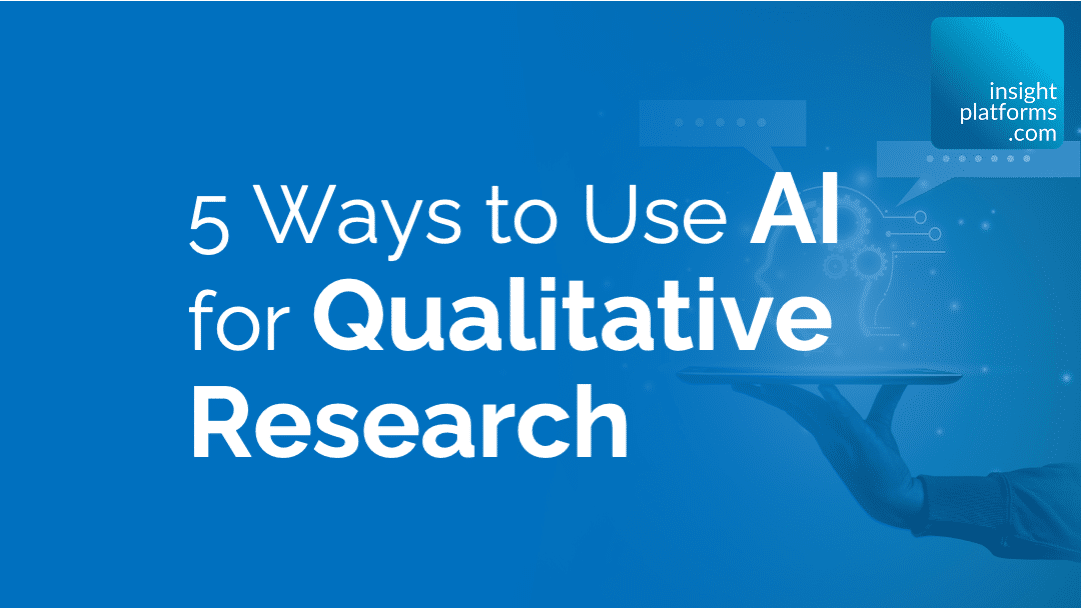
5 Ways to Use AI for Qualitative Research
By Insight Platforms
- article
- Generative AI
- Artificial Intelligence
- Qualitative Research
- Remote Qualitative Research
- Automated Reporting
- Reporting
- Sentiment Analysis
- Qualitative Data Analysis
- Video Analytics
- Transcription
Qualitative research plays a vital role in gaining deep insights into human behavior and observing people’s experiences. So you rightfully might ask, “How could AI ever do a good job at it?!”
We hear you. Traditionally, qualitative research has been a time-consuming and labor-intensive process. However, by using AI, researchers have access to powerful tools that can streamline and enhance some (not all!) aspects of a qualitative project.
In this article, we will explore five practical ways to use AI for qualitative research, including designing discussion guides, automating moderation, analyzing video footage, summarising qualitative interview transcripts, and drafting research reports.
Stay up to date
Subscribe to receive the Research Tools Radar and essential email updates from Insight Platforms.
Your email subscriptions are subject to the Insight Platforms Site Terms and Privacy Policy.
1. Design Discussion Guides
Natural Language Processing (NLP) technology can analyse screeners, and research briefs to identify relevant themes and topics and generate open-ended questions. While these models (used by ChatGPT and the like) don’t understand meaning per se, they are capable of making predictions based on patterns in the data they’re fed (whether that’s your input or any piece of information from the internet). They’re certainly able to take the first stab at a discussion guide draft that you can later fine-tune to meet project goals.
For example, qualitative research specialist platforms, like Voxpopme, are utilizing AI Discussion guides that streamline the interview or discussion process to ensure all relevant topics are covered, questions are comprehensible, and that the interview maintains consistency to best analyse collected data and insights.
Another example of qualitative research platforms using AI-powered discussion guides is Qualzy’s recently launched AI-Assisted Moderator Probe, which was designed to improve the interaction between moderators and participants. Using the AI assistant tool, moderators are able to submit their discussion guide to an open-ended program that will then suggest an edited and optimised version of the discussion guide.
Find out more about these tools here:
2. Automate Moderation
Research tools using AI can automate the moderation process by (again) using NLP algorithms to identify, categorise, and respond to user-generated content (think online diaries or user tests). For example, conversational surveys use AI chatbot tools to moderate individual or large-scale qualitative discussions, and they can conduct live interviews with participants to discover insights previously missed by restricted closed-question or open-ended surveys.
The automated moderators are also designed to further probe respondents for more in-depth feedback by asking personalised follow-up questions that encourage a deeper analysis of qualitative insights, all in an efficient and automated process.
Nexxt Intelligence’s Conversational AI platform Inca includes an AI Chatbot that uses Natural Language Processing (NLP) to moderate conversations with individuals or broader audiences. The AI chatbot listens to the participant(s), is able to interpret or understand a user’s response, and even inquires for more in-depth responses based on requested research objectives.
HumanListening™ is an AI-driven market research platform that offers a suite of applications for qualitative research, including conversational AI and text analytics. The platform allows for two-way conversations, adapting probes based on responses, and provides features such as auto-coding, sentiment analysis, and data visualisation.
Tellet.ai offers insights through AI-powered interviews and analysis using an AI interviewer that conducts interviews in 30 languages and is also able to summarise and analyse interviews. The AI feature can also identify themes, patterns, and key quotes.
Find out more about these tools here:
3. Analyse Video Footage
Video is a rich source of qualitative insights. AI dramatically improves access to those insights by transcribing and translating the content of video in near real-time. Automated sentiment analysis can then be applied to the transcribed text. This helps researchers get a more objective and standardised approach to analyzing video footage and surfaces the nuances and emotions that reveal how customers truly feel about products and services.
For example, Voxpopme has created an automated sentiment analysis tool to help researchers save time and energy understanding video research by utilizing an automated process that analyses video content to determine an accurate, overall sentiment score.
Knit’s AI Contextual Analysis™ offers speed-to-insight for customer feedback through video and open-ended responses. They provide end-to-end insights with quantitative, qualitative, and video research capabilities. Knit’s AI platform analyses data and auto-generates summaries, reports, and highlight reels.
Discuss.io is a platform designed to scale qualitative research with generative AI-powered insights. They offer a connected platform for qualitative research tools that captures sentiments, themes and features a highlight reel of important moments.
Indeemo is a video research platform that leverages video, mobile, and AI to capture in-the-moment behavior. The tool uses generative AI prompts to analyse interviews and focus groups from Microsoft Teams or Zoom.
But AI’s role in video doesn’t end with analysing language. Ethnographic research relies a lot on video footage and AI is increasingly helping researchers by automatically detecting and categorising specific actions or behaviours. For example, AI algorithms can identify facial expressions, body language, or gestures that convey emotions or attitudes.
Find out more about these tools here:
4. Summarise Qualitative Interview Transcripts
The task of analyzing and summarizing the content of qualitative interview transcripts can often prove to be quite arduous and time-consuming. Having to meticulously go through the data and identify key points can take up a great deal of time.
Fortunately, we have our good friends Large Language Models. They have the ability to streamline this process by automatically extracting the most crucial themes, concepts, and sentiments from the transcripts of IDIs or focus groups.
For example, transcript summarizing tools, like Yabble Summarize, utilize AI natural language processing technology to quickly create accurate and research-backed summaries from long-form data sources like interviews or podcasts.
CoLoop.ai is an AI copilot that identifies themes and generates summaries, answers, and slides from audio, video, transcripts, community data, or directly from Zoom.
Speak.ai is a no-code platform that uses AI to extract insights from unstructured language data. The platform offers features like automated transcription, analysis, data visualisation, and supports multiple languages.
Find out more about these tools here:
5. Draft Research Reports
Even at the final stages of a study, there are various stages where AI can be a valuable asset. Whether it’s identifying recurring themes in large volumes of data, organizing your findings in a logical and coherent manner, or summarizing complex text into digestible insights, AI can simplify synthesising information to prepare your report.
Naturally, these machine-generated first drafts are not going to be the ones you eventually present to stakeholders. They will require some human intervention for refinement but it’s better to start from a rough draft than staring at a blank screen.
NLP-based tools like Writesonic, an AI content creation platform, offer solutions for content writing, audio generation, and image crafting. On the other hand, Beautiful.ai is a generative AI presentation software that provides templates, real-time design adaptation, and team collaboration.
If you’re looking for more specific tools, here’s Quillit AI, an AI report-generating tool, that is designed to assist qualitative researchers in identifying and presenting the key insight in report writing from video content, audio, and transcripts from IDIs. The AI tool can draft an outline or an entire first draft of a report, complete with generated quotes and organized headers.
Find out more about these tools here:
AI is certainly making an impact on qualitative research projects by offering innovative solutions to enhance various stages of the project. From designing discussion guides to automating moderation, analyzing video footage, summarizing interview transcripts, and drafting research reports, AI-powered tools can significantly improve the speed, conciseness, and effectiveness of qualitative research. As technology continues to advance, the potential for AI in qualitative research will only continue to grow, opening up new possibilities for researchers worldwide.













